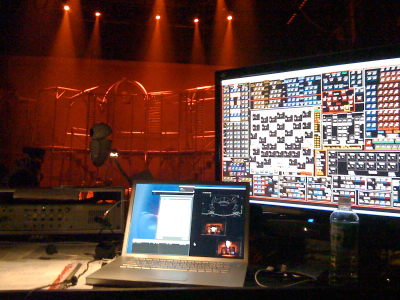
Dicken’s Tale on Broadway
Saturday, September 6, 2008
A New Paradigm for Lighting Control on Broadway.
“A Tale of Two Cities” is the first Broadway production to integrate three recent developments in lighting control. Strand Lighting’s Light Palette VL (with Universal Attribute Control) combine with “WYSIWYG” and “Virtual Magic Sheet” for a more dynamic, intuitive and designer-friendly graphic representation of the output and orientation of the stage lighting installation.
The tradition of setting cues for stage lighting has long included reliance by the lighting designer on an elaborate array of papers and mnemonic devices to identify the dimmers and their levels, as well as the positions of the stage lights. While a small Off-Broadway show may use 12 or 24 dimmers, A Tale of Two Cities employs over 1,300 channels of lighting control for the dimmers, robotic lights, fog machines and other effects. The advancing maturity of the lighting designer’s art, inspired by the trend in modern productions toward cinematic images, pushes the limits of organization and record-keeping for the designer, potentially hindering the ability to react spontaneously and efficiently to inspiration as it occurs during technical rehearsals.
In the Sixties, lighting designer Richard Pilbrow sought a simpler and more intuitive method of lighting control. Reacting to the tradition of multiple potentiometers, teams of men raising and lowering levers backstage, and elaborate pipe-organ styled consoles, he developed Lightboard for London’s National Theatre. This computer memory control, followed by developments in the US, changed the craft and technique of stage lighting. In 1976 on Broadway, the first production to use computer control for stage lighting was A Chorus Line, designed by Tharon Musser. Theatrical vendors, unions and landlords adapted, and now all Broadway productions use computerized lighting control that memorizes every state of lighting and reproduces it exactly on demand.
The introduction of computer controlled ‘robotic’ lighting — lights able to remotely change direction, color and beam characteristics greatly increased the demands placed upon lighting control. From simply control of a light’s brightness, these new automated fixtures might have as many as 36 differant attributes all requiring memorization. The computer memory board that had speeded up the lighting process found itself overwhelmed in complexity. So many variables require a new and streamlined approach. Many developments ensued, all seeking to both provide accessible information to the designer about the new complex design choices that existed and allow their rapid manipulation in rehearsal as the lighting design evolved.
People often misunderstand the implication of a computerized tool used for a show with human actors, and assume that timing and other variations in an actor’s performance is at odds with the technology. The tools of theatrical control mimic traditional methods, however, so a stage manager still cues things to “go” based on the movements of the actors, the music or the scenery. Despite the increase in technology, every performance is still unique, and depends on the ancient relationship between performer and audience.
“A Tale of Two Cities” is the first Broadway production to integrate Strand Lighting’s Light Palette VL (with Universal Attribute Control developed by Robert Bell) with Cast Lighting’s WYSIWYG and West Side Systems’ Virtual Magic Sheet (developed by Eric Cornwell) for a more dynamic, intuitive and designer-friendly graphic representation of the output and orientation of the lighting rig. Universal Attribute Control allows moving light fixtures to be addressed in ‘plain language’: “15° left, color light blue, shutters close in and rotate 12°” to apply to any or every chosen instrument regardless of type or manufacture. Interactive WYSIWYG provides three-dimensional visualization of the stage and each moving light may be selected and moved via “touch-and-drag” on a video monitor. Finally Eric Cornwell’s Virtual Magic Sheet provides a dynamic display that shows every lighting channel, its color, direction and intensity in real-time, thus instantly revealing the relative contribution of every light to the stage lighting picture for rapid modification. The link between the images in the designer’s imagination are thus powerfully and immediately linked to the reality onstage.
Pilbrow configured a video display to indicate, graphically, and in real time, levels and positions of lights. He cued the show (with over 1,300 control channels of moving and conventional fixtures, LED’s, fibre-optics, special effects and over 80 radio-controlled battery-powered instruments) without any other display from the lighting console, working alongside the actors as they rehearsed onstage. The VMS display can be connected to the lighting control via Wi-Fi allowing the designer to monitor his lighting from anywhere in the theatre.
Lighting Designer: Richard Pilbrow
Associate Lighting Designer: Michael Gottlieb
Lighting Programmer: Robert Bell
Associate Lighting Programmer: Bobby Harrell
Assistant Lighting Designers: Kathleen Dobbins, Graham Kindred, Jay Scott
Production Electrician: Michael Ward
Assistant Electrician: Paul Ker
Board Operator: Robert Hale
Followspot Operators: John Blixt, Thomas Burke, Bob Miller
House Electrician: Michele Gutierrez
Director: Warren Carlyle
Scenic Designer: Tony Walton
Costume Designer: David Zinn
See also:
http://blog.livedesignonline.com/liveblog/2008/08/18/pilbrow-takes-control/
http://livedesignonline.com/theatre/revolutionary_spirit_1108/